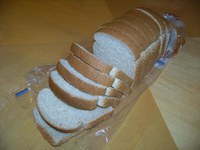Prairie Fare: Save Some Bread With These Tips
(Click the image below to view a high-resolution image that can be downloaded)
By Julie Garden-Robinson, Food and Nutrition Specialist
NDSU Extension Service
“Does the bread have seeds in it?” my 11-year-old daughter asked.
“The bread has no seeds,” I responded as I flipped the slices of french toast on the griddle.
I am well aware that my youngest child does not like bread with added ingredients such as seeds and nuts. Usually she picks out all the nonbread material and sets it by her plate, much to my chagrin.
I thought she might be OK with the cinnamon and nutmeg in the french toast egg mixture, though.
“Is this going to be mushy like the chocolate bread pudding?” she asked, wrinkling her nose. She had a definite idea of what the texture of pudding should be: smooth and creamy.
“No, the french toast won’t be mushy. The chocolate bread pudding was supposed to be kind of mushy, by the way. Everyone else liked it,” I responded a bit defensively.
My daughter brings out my “inner sixth grader” sometimes.
I was testing some bread recipes for a publication about using “stale” bread, which local food pantries have requested. My home kitchen experiments reminded me of my days as a cereal chemistry graduate student, but I have no lab equipment in my kitchen.
Stale bread usually is firmer and may crumble readily, so people might opt to toss it instead of using it in novel ways.
Bread is a good source of complex carbohydrates, B vitamins and iron. Using day-old bread can help you stretch your food dollars. If you choose whole-grain bread, you have the added nutritional benefit of fiber and phytochemicals (beneficial “plant chemicals”) because the germ and bran are present.
Have you ever had a loaf of bread become moldy or stale on your countertop? At some point in our lives, most of us have found a colorful, fuzzy surprise when we opened a bread bag.
Storing bread in the refrigerator will slow down the rate at which bread will grow mold. However, refrigerating bread actually speeds staling. Refrigerated bread becomes stale six times faster than bread at room temperature. Freezing bread, on the other hand, delays staling.
If your bread becomes moldy, you need to throw it away. However, stale bread can be “revived” by toasting or otherwise heating it.
The staling of bread originally was studied in the early 1850s. Staling is not merely the loss of moisture. The early food scientists sealed the bread in containers and measured the moisture content. They noted no change in moisture content, so the water was still present in the stale bread.
During staling, the bread becomes firmer as the tiny starch granules in the crust change their alignment in the bread. The starch granules squeeze out the water into other areas of the crumb.
That was the chemistry lesson of the day. Here are some practical tips to save some bread:
- Freeze the bread. Seal it in an air-tight bag, then label the package with the date you froze it. Usually, bread will remain at high quality for about three months in your freezer.
- Make croutons or bread crumbs. Simply cut the bread in cubes or tear into small pieces, and bake at 350 degrees until it is dry and brittle. To make crumbs, use a rolling pin to crush the bread to the desired size. You can add your favorite salt-free seasonings, such as garlic powder, if you like.
- Use bread as a meat extender. Some recipes call for soft bread crumbs and others call for toasted cubes. Add the bread crumbs to ground beef to make meat loaf or meatballs. Top casseroles with toasted bread crumbs for a little crunch or in place of crackers.
- Try making recipes with day-old bread such as french toast, egg bake, bread pudding, stuffing/dressing, grilled cheese sandwiches, egg salad on toast or garlic toast.
Four out of five Robinsons and our neighbor enjoyed this bread pudding recipe. I served it with whipped topping, strawberries and blueberries. Add a drizzle of chocolate syrup if you want to be extra fancy.
Chocolate Bread Pudding
3 c. fat-free milk, divided*
1 c. semisweet chocolate chips
1 c. sugar
2 Tbsp. margarine or butter
8 slices white or whole-wheat bread (day old, cubed)
1 tsp. vanilla
1 tsp. ground cinnamon (optional)
3 eggs, lightly beaten
Fresh fruit such as strawberries or raspberries, whipped topping (optional)
(*)Be sure to follow the recipe directions for addition of milk.
Preheat the oven to 350 degrees. Grease a 1 1/2-quart baking dish and set aside. In a large saucepan, combine 2 cups milk, chocolate, sugar and margarine. Stir over medium heat until chocolate and margarine (or butter) are melted. Remove from heat and stir in cubed bread, vanilla, cinnamon (if desired) and remaining 1 cup of milk. Add eggs and mix. Bake for 45 to 55 minutes or until a knife inserted in the center comes out clean. Serve warm with a dollop of whipped topping and berries.
Makes 12 servings (about 1/2 cup per serving). Each serving has 220 calories, 9 grams (g) of fat, 31 g of carbohydrate, 7 g of protein and 150 milligrams of sodium.
(Julie Garden-Robinson, Ph.D., R.D., L.R.D., is a North Dakota State University Extension Service food and nutrition specialist and professor in the Department of Health, Nutrition and Exercise Sciences.)
NDSU Agriculture Communication – Jan. 22, 2015
| Source: | Julie Garden-Robinson, (701) 231-7187, julie.garden-robinson@ndsu.edu |
|---|---|
| Editor: | Rich Mattern, (701) 231-6136, richard.mattern@ndsu.edu |


